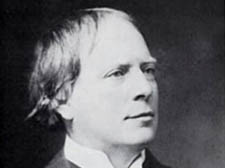|
|
 |
| |

Arthur Machen: inspired by walking through London’s ‘unending, murmuring streets’ |
Writer behind nightmares is reawakened
Arthur Machen, the dark force who inspired some of today’s top horror authors, is set to be revived, writes Peter Gruner
ARTHUR Machen inspired countless horror and fantasy writers, from HP Lovecraft to Stephen King, but today he is virtually unknown.
Now the author who found inspiration on the streets of Islington and Camden is about to be rediscovered thanks to research by a north London historian.
Machen was an exponent of the great Gothic horror and the “decadent movement” of the 1890s, espoused by the likes of Robert Louis Stevenson for Dr Jekyll and Mr Hyde and Bram Stoker for Dracula.
Born in 1863 in Caerleon, the son of a respectable and conventional Minister of the Church of Wales, Machen believed that behind the veneer of so-called reality lay a strange world which could lead to madness, sex or death – and usually a combination of all three.
An early book, The Great God Pan, appeared in 1894 to hostile reviews and was summed up by the Westminster Gazette as “an incoherent nightmare of sex”.
Today such a review would have been praise indeed, but for almost a century this writer, poet and mystic has been virtually forgotten – although he has always inspired a band of devoted band of followers.
Andrew Granath wants the literary world to look again at the joys of Machen, and his love of London with its “unending, murmuring streets”. Like Dr Johnson, Machen never tired of the capital and wrote: “…he who cannot find wonder, mystery, awe, the sense of a new world and an undiscovered realm in the places by the Gray’s Inn Road will never find those secrets elsewhere, not in the heart of Africa, not in the fabled hidden cities of Tibet.”
He was fascinated by what he called “the infinitude of London and those parts that lay on the fringes Barnsbury, Canonbury, Kensal Green and Shepherd’s Bush beyond which lay ‘terra incognita’, the unknown world”.
Mr Granath, who teaches history and politics at Latymer School in Edmonton, is currently working on a new book about Machen’s London, provisionally titled Arthur Machen’s London: The Goblin City. He believes that Machen “shared William Blake’s view of the world”, one that was inhabited by strange beings. Although many of his occult books are still available, his less well-known London writings are out of print.
Surprisingly, apart from a version of The Shining Pyramid which was screened on British TV in 1980, none of his works has been adapted for film. However, films such as Guillermo del Toro’s Pan’s Labyrinth (2006), and John Carpenter’s 1980 film The Fog are said to have been influenced by him.
But Machen was also an old fogey in his time. With changes brought about by the First World War he loathed both the “nursery hours of today” and “the monstrous incursion of women”. He believed that “the old tavern life has gone utterly and forever”. He could never bring himself to call them “pubs”.
Mr Granath observes that “Machen was ambivalent about Islington’s squares. He thought they were jerry-built but at the same time he was fascinated by the ‘hidden places’ where the ‘silent people’ lived.” Today they are the most fashionable parts of the borough.
Typically, he disliked the new St Pancras station: “Unlike many who swooned over the building, Machen dismissed it as Gilbert Scott’s ‘monstrous folly’.”
Mr Granath is a member of the Friends of Arthur Machen, an online group who do much to promote the author, as well as arranging walks and dinners. Machen was briefly a journalist on the Evening News (now incorporated into the Evening Standard), an occupation that he loathed.
He lived in St John’s Wood where he organised literary gatherings for friends, including Augustus John, Wyndham Lewis, and Jerome K Jerome.
He became particularly famous for his 1914 story The Bowmen, a tale of the ghostly archers of Agincourt coming to the aid of the retreating English. The story was retold by a nurse on the Western Front to cheer her wounded soldiers and it found its way back to the British papers as The Angel of Mons.
Mr Granath believes that Machen is important both as a prose stylist and for his original views of London: “I managed to discover his Miscellany of London in Ripping Yarns bookshop in Highgate.”
He wrote of those living in genteel poverty in Camden Town in the 1840s, Fairyland in Soho, the joys of riding in a jingling horse-drawn hansom cab, dastardly murders at Highbury, jolly times in Merrie Islington, the old London fogs in which a man could disappear never to be seen again and of the Great Magisterium who lived in Brentford.
Towards the end of his life – his writings out of fashion and in a state of some poverty – the great and good of the literary world including TS Eliot campaigned for Machen to receive a Civil List pension of £100 a year that saw him through his final years. He died in 1947 aged 84.
|

|
 |
|
 |
|

